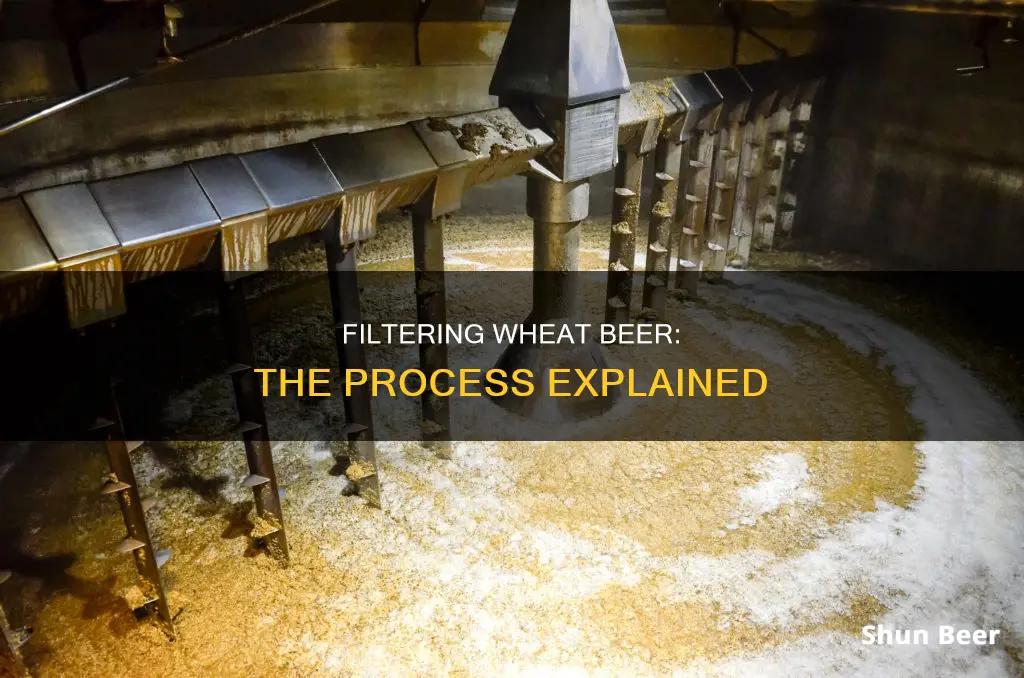
Wheat beer is a top-fermented beer with a large proportion of wheat relative to malted barley. The two main varieties are German Weizenbier and Belgian Witbier. Wheat beer is typically creamy, tangy, and refreshing. The broad family of wheat beers includes Witbier, Weisse, and Weizen. Witbiers are Belgian-style wheat ales or white beers, made with raw unmalted wheat and flavourings like coriander and orange peel. Weisse is the German word for white, used for the sour Berliner type of beer. Weizen is German for wheat, applied to the Bavarian wheat beer style. So, is wheat beer filtered? The answer is, it depends. While some wheat beers are unfiltered, like the Hefeweizen style, others are filtered, like Kristallweizen.
What You'll Learn

Unfiltered wheat beer has a stronger fragrance
Unfiltered wheat beer is effectively beer in its rustic form, or an unfinished state. It is the way beer exists after being brewed, before it has been filtered. Unfiltered beers were initially considered dirty because of their cloudy and hazy look. However, over time, they have become appreciated for their appearance, with some finding the clean, glittering pale colour of filtered beer more attractive.
Unfiltered wheat beer is also more flavourful because of the presence of yeast, hops, and barley. They are bitter and have a grainy texture and hints of many flavours. Filtered beers, on the other hand, are smooth and have a clean and crisp texture.
Unfiltered wheat beer is also said to be healthier than filtered beer. This is because yeast contains vitamin B, which helps curtail hangovers and their effects. Unfiltered beer is also more fibre-rich.
Wheat beer is a large category of beer styles, including witbiers, hefeweizens, Berliner-style Weisse, and American wheat beers. The main defining characteristic of a wheat ale is the heavy presence of wheat in the grain bill. Most brewers prefer barley because it is less tricky to work with.
Wheat Beers: Healthy Choice or Just Hype?
You may want to see also

Filtration removes yeast and malt
Filtration is a process that removes sediment from beer, including yeast and malt. The process was introduced at the end of the 19th century and uses mechanical means to clarify the beer. Filtration can be done in various ways, from ancient techniques using straw mats, cloth, or straws to modern methods involving mechanical filtration.
Modern filtration involves flowing the beer through layers of filter material, with the two main techniques being surface filtration and cake filtration. Filters can range from rough to fine or even sterile. Rough filtration removes much of the yeast and solids (such as hops and grain particles) while fine filtration yields a nearly transparent beer. Sterile filtration removes almost all microorganisms, including bacteria, from the beer.
Filtration is commonly used by commercial brewers to improve the flavour and clarity of their beer. It is a quick and cost-effective way to remove impurities and haze-causing particles, ensuring a smooth and clear final product. However, some brewers, particularly home brewers, may choose not to filter their beer to preserve the raw flavour or due to a lack of necessary equipment.
The filtration process can also affect the flavour of the beer. While it removes haze and impurities, over-filtration can strip the beer of its flavour and beneficial compounds. Therefore, it is important to choose the appropriate filter size, usually around 1 micron, to balance clarity and taste.
In summary, filtration is a process that removes yeast, malt, and other sediments from beer, improving its clarity and flavour. It is a common practice in commercial brewing but may be avoided by some home brewers to preserve flavour or due to equipment limitations. The type of filtration and filter size can impact the final taste and appearance of the beer.
Wheat in Sapporo Beer: What You Need to Know
You may want to see also

Unfiltered wheat beer is more nutritious
Wheat beer has a long history that dates back to the 16th century in Bavaria, Germany. At that time, the Bavarian Duke, Wilhelm V, introduced a law that permitted the brewing of beer with wheat, in addition to barley. This new type of beer, named Weissbier, meaning "white beer", quickly gained popularity due to its cloudy appearance and refreshing taste.
Unfiltered wheat beer is a rich source of vitamins and minerals. It contains vitamin B, iron, magnesium, and potassium, which offer various health benefits. These nutrients can boost your immune system, improve digestion, and even reduce the risk of heart disease. Additionally, the beer's antioxidants help prevent cell damage and reduce inflammation in the body.
The natural citrusy flavor and cloudy appearance of unfiltered wheat beer make it a refreshing choice, especially during warm weather. It has a lower bitterness level and a sweet, bready flavor that appeals to many drinkers. The low alcohol content, ranging from 3% to 6% ABV, makes it a pleasant and easy-drinking option.
With its combination of flavor, refreshment, and health benefits, unfiltered wheat beer offers a nutritious choice for beer enthusiasts. It pairs well with a variety of foods, including salads, seafood, poultry, and spicy dishes, making it a versatile beverage for any occasion.
Sour Beers: Do They Contain Wheat?
You may want to see also

Unfiltered wheat beer is considered 'dirty'
Unfiltered wheat beer is considered dirty due to misconceptions about its appearance and the brewing process. For many years, crystal-clear beers were considered the standard for quality, and any deviation from this clarity was seen as a sign of imperfection or unfinished brewing. As a result, unfiltered beers, with their hazy or cloudy appearance, were often associated with being dirty or incomplete.
However, the perception of unfiltered wheat beer as "dirty" is unfounded and incorrect. The haze or cloudiness in unfiltered wheat beer is not due to impurities but is a natural result of the brewing process, where the beer has not undergone additional filtration to remove sediment and particles. This lack of filtration gives unfiltered wheat beer its distinctive appearance and contributes to its unique characteristics.
Unfiltered wheat beer has become increasingly popular, setting the stage for a craft beer revolution. Its natural citrus flavor, low bitterness, and refreshing taste have made it a beloved choice for beer enthusiasts. The haze or cloudiness in the beer is not only accepted but also celebrated as a sign of authenticity and character.
The misconception that unfiltered wheat beer is dirty may also stem from the presence of yeast and other proteins in the beer. Yeast is an essential ingredient in the brewing process, and its presence can enhance the flavor, aroma, and nutritional value of the beer. While some people may find the stronger aroma and complex taste of unfiltered wheat beer less appealing than the crispness of filtered beers, it is not an indication of dirtiness or poor quality.
In summary, the perception of unfiltered wheat beer as dirty is a result of outdated notions of beer clarity and a misunderstanding of the brewing process. Unfiltered wheat beer offers a unique sensory experience with its hazy appearance, complex flavors, and aromatic qualities. Embracing the characteristics of unfiltered wheat beer allows beer lovers to appreciate the diverse and fascinating world of craft brewing.
Stella Beer: Wheat-Free or Not?
You may want to see also

Filtration methods vary
The filtration process for wheat beer varies depending on the type of beer, the desired outcome, and the scale of the brewing operation. Here are some common filtration methods used in the beer industry, including those specific to wheat beer:
Surface Filtration
Surface filtration, also known as depth filtration, uses filter sheets or cartridges made from materials like cellulose, perlite, or diatomaceous earth. These filters have tiny pores that trap particles, allowing clear beer to pass through. This method is perfect for removing larger particles and is often used after the beer has undergone some initial clarification through settling or centrifugation. While it is cost-effective and user-friendly, surface filtration may require pre-filtration for optimal results, and the filter sheets or cartridges need frequent replacement.
Cake Filtration
Cake filtration involves building a "cake" of filter aid, such as diatomaceous earth or perlite, on the surface of a filter screen. As the beer passes through this cake, particles are trapped, resulting in a clear product. This method is highly effective at removing fine particles and producing a brilliantly clear beer. However, it can be labor-intensive, requiring careful monitoring, and may be challenging to scale up for larger operations.
Cold Filtering
Cold filtering is a popular method among larger breweries due to its effectiveness and scalability. It involves chilling the beer to near-freezing temperatures, causing haze-causing proteins and polyphenols to clump together and settle out. The beer is then passed through a filter to remove these larger particles. While cold filtering ensures enhanced clarity, it may strip some flavour compounds, resulting in a less complex taste profile. It also requires precise temperature control and specialised equipment.
Sheet Filters
Sheet filters are pre-made media that are relatively straightforward to use. Brewers can choose the desired level of filtration fineness, and the sheets are placed into a filtering frame, sterilised, and then used to filter the beer. If the filter becomes blocked, the sheets can be flushed, and they are typically disposable, replaced between filtration sessions. Sheet filters are usually sold in nominal ratings, and 90% of particles larger than the nominal rating are caught. For sterile filtration, a typical size is 1 micrometre or less.
Powder Filters
Filters that use a powder medium, such as diatomaceous earth or perlite, are more complicated to operate but can filter much larger volumes of beer before needing regeneration.
Unfiltered Wheat Beer
It is worth noting that some wheat beers are intentionally left unfiltered, such as the Hefeweizen style, which includes the popular German Weizenbier and Belgian Witbier varieties. Unfiltered wheat beer has a distinctive hazy appearance and is known for its natural citrus flavour.
The Wheat Beer Experience: Flavor, Aroma, and Taste
You may want to see also
Frequently asked questions
Wheat beer is a top-fermented beer brewed with a large proportion of wheat relative to the amount of malted barley. Wheat beer has a creamy texture and a golden appearance with a noticeable hazy quality and a pronounced foam head.
The two main varieties are German Weizenbier and Belgian witbier. Other types include Lambic (made with wild yeast), Berliner Weisse (a cloudy, sour beer), and Gose (a sour, salty beer).
Wheat beer typically has a bready, citrusy, bright, and spicy taste, with common flavor notes like coriander, orange peel, lemon, honey, and pepper.







